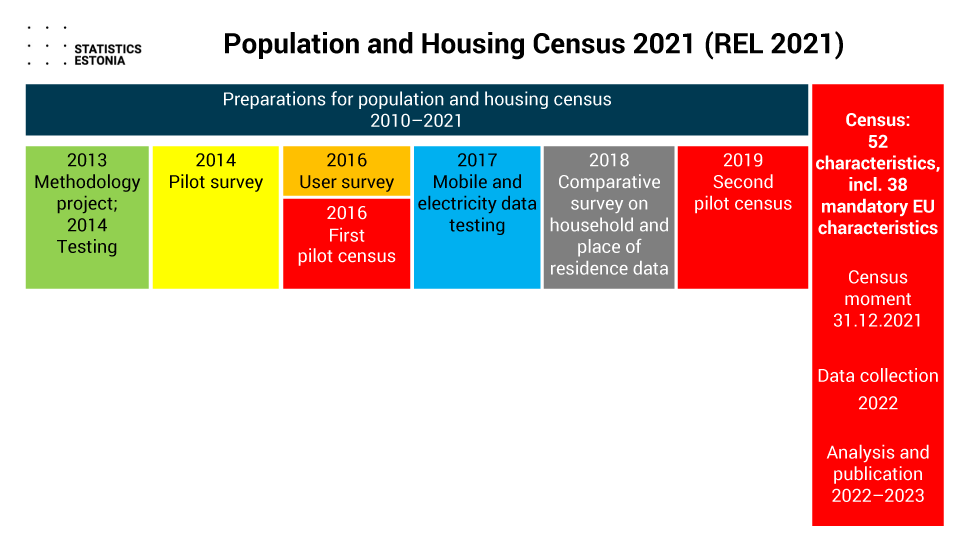Population census 2021
Population and Housing Census 2021
A population and housing census is the collection, analysis and aggregation of data with a precise census moment in order to determine the composition, location, economic and social distribution, etc. of the population.
Who conducts the census?
In Europe, the statistical office of the European Union, Eurostat, coordinates population and housing censuses. Eurostat obliges Member States to carry out a population census in a given year and determines a precise list of mandatory output characteristics and their format, in order to ensure the comparability of data across Member States.
In Estonia, the census is conducted by Statistics Estonia.
Census moment
The census moment for the Estonian population and housing census 2021 is 31 December 2021. The data collected in the census must be reported as at the census moment, regardless of the time and mode of response. Data collection will take place in early 2022.
Estonia’s 2021 population census shall be carried out using the combined method
This means using data from state databases, i.e. registers, and requesting data directly from people in order to obtain information that is not available in registers. The dataset or census characteristics for which data are collected in the census have been fixed in the Official Statistics Act and Regulation 763/2008 of the European Parliament and of the Council.
The development of registers is necessary
Getting people to participate in the census is a global problem, which is solved by register-based census, where the registers are cross-used to obtain data that are more accurate. According to the European Commission’s draft legislation, from 2024 onwards, all EU countries should carry out a census every year, so the use of registers in Estonia’s combined census in 2021 is justified, as is the future transition to a fully register-based census. Investments in registers are essential and the development of registers is also important.
The preparatory work for the 2021 census has been carried out at Statistics Estonia over a decade (2010–2019). The total cost is almost 16 million euros, half of which has been used in ministries to develop registers and improve data quality. The census work will continue in 2020–2023 and will end in 2024 when all census results have been published.
What is meant by using registers in the census?
This means using the information that has been submitted in state databases, i.e. registers.
Statistics Estonia has carried out methodological and information technology preparatory work since 2010 to use data from registers in the 2021 Population and Housing Census. A pilot survey (in 2014) and two pilot censuses (the first in 2016 and the second in 2019) have been carried out to evaluate the method.
Estonia has a good system of national registers with data on all residents and dwellings in Estonia. It is natural to use these data for conducting the census, as well as in other national statistical activities.
In organising the 2021 census, Statistics Estonia cooperates with at least 24 registries. In addition to the main registers – the population register, the registers of the Land Board, the Tax and Customs Board and the Health Insurance Fund – information from other state databases is used to complement and improve the accuracy of the results.
What should be done in databases?
Databases play an important role in a register-based census. The administrator of each database shall ensure that the dataset is complete, containing all the data required by the statutes of the database. All data must be accurate, complete and up-to-date. The register-based census requires a secure and operational data exchange platform. Estonia uses the internationally recognised X-Road, which was developed in Estonia.
Cooperation in preparation of the register-based census contributes to the data quality of all databases, making the use of these databases more efficient for the benefit of society.
Requirements for register-based census
- State databases
- Coverage of state databases – total population and dwellings must be covered
- Continuous updating and quality of data in state databases, ensured by consistent control
- Compatibility of state databases (incl. compliance of all addresses with the address standard)
- Consistency of definitions and concepts in state databases with those used (internationally) in population censuses
State databases for the 2021 census
RR – Population Register; EHIS – Estonian Education Information System; MKR – Register of Taxable Persons; EHR – National Register of Buildings; KR – Land Register; ARIREG – Commercial Register; STAR – Social Services and Benefits Registry; KIRST – Health Insurance Information System; KVKR – National Defence Obligation Register; EMPIS – Estonian Unemployment Information System; KOPIS – Mandatory Funded Pension Register; TÖR – Employment Register; ETR – Register of Residence and Work Permits; the Land Board’s address data system (ADS system); E-file system; KMAIS – Identity Documents Database; Traffic Register, EMSR – Estonian Medical Birth Register; RETS – Estonian Medical Prescription Centre; SAP – State Personnel and Payroll Database; SKAIS – Social Security Information System; RAKS – Register of Granting International Protection; SPR – Causes of Death Register; TETRIS – Database of Work Ability Assessment and Work Ability Allowance; KIR – Prisoners’ Register.
Population and Housing Census in 2011
